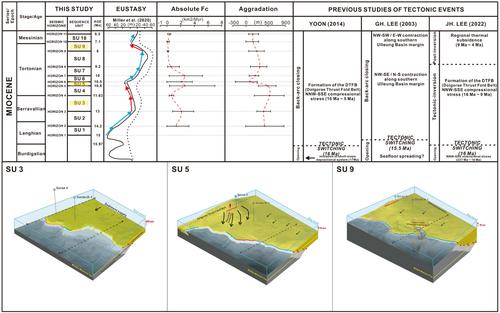当前位置:
X-MOL 学术
›
Basin Res.
›
论文详情
Our official English website, www.x-mol.net, welcomes your
feedback! (Note: you will need to create a separate account there.)
Architecture and evolution of shelf‐margin clinoforms developed in a back‐arc tectonic setting: Insights from quantitative analysis on the south‐west shelf margin of the Ulleung Basin
Basin Research ( IF 2.8 ) Pub Date : 2024-03-05 , DOI: 10.1111/bre.12859 Gihun Song 1, 2 , Hyun Suk Lee 1, 2 , Seungcheol Lee 3
Basin Research ( IF 2.8 ) Pub Date : 2024-03-05 , DOI: 10.1111/bre.12859 Gihun Song 1, 2 , Hyun Suk Lee 1, 2 , Seungcheol Lee 3
Affiliation

|
Geophysical and geological research in the Ulleung Basin has been ongoing since the 1970s, involving continuous seismic acquisition and multiple well‐drilling projects. This study utilized an integrated quantitative approach with conventional seismic interpretation based on recent trends to understand the history of the shelf‐margin development and individual controls that may have influenced each period in the Ulleung Basin. Quantitative analysis was conducted by measuring the progradation (Pse ), aggradation (Ase ) and sediment influx (Fc) of individual shelf margins in seven dip‐oriented seismic profiles, and calculating the shelf‐edge gradient (αse ) and the P/A ratio. Based on these data and the ratio of accommodation to sediment supply (A/S ratio ), which was interpreted from the stratal stacking pattern, five shelf‐edge trajectory types were defined and assigned to each shelf margin. By considering individual controls (eustatic fluctuations, sediment supply and tectonic events), we defined the three evolution intervals of the Ulleung Basin during the Middle Miocene to Late Miocene (15 to 6.5 Ma): (1) the upper Middle Miocene (15 to 11.63 Ma) characterized by a moderate sediment supply and high aggradation margin induced by rapid subsidence, (2) the lower Upper Miocene (10.8 to 10 Ma) as a high sediment supply and low aggradation margin associated with reworked sediments from the uplifted Dolgorae Thrust and (3) the uppermost Miocene (9.2 to 6.5 Ma) characterized by a low sediment supply and low aggradation margin experiencing sediment starvation. A comparison with worldwide continental margins indicated that the Ulleung Basin formed under a relatively low rate of progradation (low sediment supply; 4.79 km/Myr) and a high rate of aggradation (high shelf accommodation; 361.04 m/Myr) condition. The SW margin of the Ulleung Basin provides a unique example of understanding stratigraphic architecture variations under changing stress regimes of back‐arc setting (extensional to compressional) and understanding of individual controls that influence margin development.
中文翻译:

弧后构造背景下陆架边缘斜形的结构与演化——郁陵盆地西南陆架边缘定量分析的启示
郁陵盆地的地球物理和地质研究自 20 世纪 70 年代以来一直在进行,涉及连续地震采集和多个钻井项目。本研究利用基于最新趋势的传统地震解释的综合定量方法来了解陆架边缘发展的历史以及可能影响郁陵盆地每个时期的单独控制。通过测量进展(P硒 ), 加剧 (A硒 )和七个倾角定向地震剖面中各个陆架边缘的沉积物流入量(Fc),并计算陆架边缘梯度(α硒 )和市盈率。根据这些数据以及住宿与沉积物供应的比率(售后比 ),从地层堆积模式解释,定义了五种陆架边缘轨迹类型并分配给每个陆架边缘。综合考虑个体控制(海平面波动、沉积物供给和构造事件),我们定义了郁陵盆地中中新世至晚中新世(15~6.5Ma)的三个演化区间:(1)中中新世上部(15~11.63Ma) Ma) 的特点是中等的沉积物供应和快速沉降引起的高沉积边缘,(2) 上中新世下部 (10.8 至 10 Ma) 具有高沉积物供应和低沉积边缘,与隆起的多尔戈拉逆冲断层的再加工沉积物有关,以及 ( 3)最上层的中新世(9.2至6.5 Ma)的特点是沉积物供应量低和沉积物匮乏的低加积边缘。与世界大陆边缘的比较表明,郁陵盆地是在相对较低的进积速率(低沉积物供应;4.79 km/Myr)和较高的加积速率(高陆架容纳能力;361.04 m/Myr)条件下形成的。郁陵盆地的西南边缘提供了一个独特的例子,可以帮助我们了解弧后环境(张性到压缩性)变化的应力状态下地层结构的变化,以及了解影响边缘发育的个体控制。
更新日期:2024-03-05
中文翻译:

弧后构造背景下陆架边缘斜形的结构与演化——郁陵盆地西南陆架边缘定量分析的启示
郁陵盆地的地球物理和地质研究自 20 世纪 70 年代以来一直在进行,涉及连续地震采集和多个钻井项目。本研究利用基于最新趋势的传统地震解释的综合定量方法来了解陆架边缘发展的历史以及可能影响郁陵盆地每个时期的单独控制。通过测量进展(P






























 京公网安备 11010802027423号
京公网安备 11010802027423号